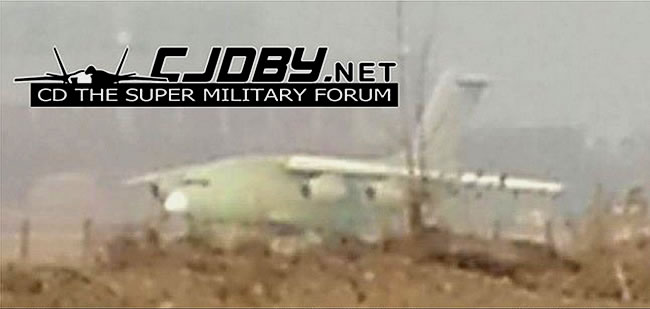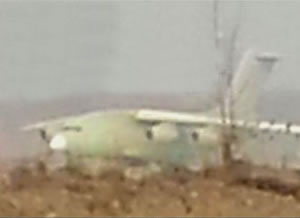In a subdued Christmas Eve presentation, Beijing has once again unveiled the presence of a new military aircraft. Chinese websites posted indistinct photographs of what is being promoted as being the first domestically-produced heavy-lift military transport.
The new aircraft, designated the Xi’an Aircraft Corporation’s Y-20, is the latest in a long series of new military aircraft China has introduced to the world recently. In a theme that is quickly becoming a Chinese tradition, the Y-20 was featured on Chinese websites in advance of a formal government announcement. Shortly after the photographs appeared, Beijing quickly confirmed that the Ministry of Defense is developing a new heavy transport, supposedly the Y-20, as part of its military modernization campaign and for service in humanitarian and disaster-relief efforts.

The photographs were purportedly taken from long range at Xi’an Aircraft’s Yanliang airfield in China’s Shaanxi Province located in east-central China. Although the websites used to display these photographs profess to be administered by Chinese aviation enthusiasts, most experts claim such presentations are actually the work of the Chinese government as a means of highlighting China’s technological prowess.
Some features of the new aircraft can be identified despite the poor quality of the images presented. The aircraft bears a striking resemblance to the US Air Force C-17 Boeing-built transport, but appears to be of a size that might fit somewhere between the C-17 and the Airbus A400M. The new Chinese tactical transport aircraft will also challenge the Brazilian C-390 scheduled to fly in 2014.
The aircraft is powered by four jet engines that appear to be Russian Soloviev D-30KU engines. The Soloviev D-30KU is a twin-shaft, low-bypass turbofan engine currently in service on Russian Ilyushin Il-62M and Tupolev TU-154M airliners and Ilyushin Il-76MD cargo transports. The Chinese People’s Liberation Army Air Force (PLAAF) currently operates a small fleet of Russian-manufactured Il-76 transports powered by the D-30KU engine.
Chinese prototype and test aircraft have frequently been fitted with older engines and parts from other aircraft prior to entering production. Some sources are speculating that a production-model of the Y-20, should it actually go into production, would likely be powered by Chinese-built, high-bypass WS-20 powerplants in lieu of the D-30KUs.
The Y-20 also features a high-wing configuration and T-tail and is estimated to weigh-in at 200 tons or so. The aircraft’s nose also shares a similarity with the Ukrainian-built Antonov An-70 medium-range transport.
Although not confirmed, several analysts believe design of the Y-20 likely began in 2005. Rumors have swirled throughout the defense community for years speculating that China was pursuing development of a heavy cargo transport. Currently, the PLAAF has a small, but growing fleet of transports that includes 20 Ilyushin Il-76 transports.
In the aftermath of a massive 2008 earthquake in Sichuan province, the PLAAF was able to deploy only a small number of transports to ferry relief supplies to the stricken area while the USAF managed to fly several fully-loaded C-17s into the area. The Chinese government considered this testimony to American air superiority to be a humiliating indictment of China’s failure to care for its own. This event likely energized Y-20 design efforts.
A model of the Y-20 was featured in a Chinese trade show in 2009, but the speed with which a full-scale model has appeared has come as a minor surprise. China is known to have pumped billions of dollars into military modernization and it is suspected that large sums have been earmarked for development of a domestically-produced turbofan engine capable of powering a heavy-lift transport.
Theoretically, the Y-20 would give China a global airborne military capability to challenge the monopoly long enjoyed by the United States. Chinese political and military leaders are painfully aware that a long-range, heavy-lift transport is necessary for China to be considered a serious force of global reach.
As can be said of many prototype aircraft that have appeared throughout aviation history, the appearance of a full-scale model doesn’t always translate into production of a model capable of delivering a level of performance equaling that demonstrated by existing aircraft currently in operation. This is especially true of the Y-20 since Chinese designers have struggled for years to develop a domestic engine capable of powering an aircraft of this size.
Although many defense analysts continue to downplay advances in Chinese technology, it is true that Beijing has made remarkable progress in its space program, in developing advanced military hardware, and in conducting intricate military operations mastered by only a small number of nations.
As with all new advances unveiled by Beijing, questions will continue to fuel speculation that the Y-20, and a majority of China’s recently publicized military aircraft, is based on stolen technology. A Chinese-born engineer working for Boeing was found guilty of delivering classified information related to American rocket technology to Chinese agents in 2010 and was sentenced to 15 years in prison. This same individual was accused of attempting to deliver classified data related to the C-17, but this charge was subsequently dropped.
While the technology featured in the Y-20 may eventually be discovered to be copied from other aircraft, such knowledge will have minimal impact on future development of Chinese aircraft.
Of greater importance is recognition of the expanded capabilities a truly functional Y-20 would give China. A fleet of Y-20s would enable China to transport significant military forces far beyond its own borders. In order to challenge US capabilities, many analysts estimate China would require a fleet of at least 300 heavy-lift aircraft, an estimate that may not be outside the realm of possibility.




















